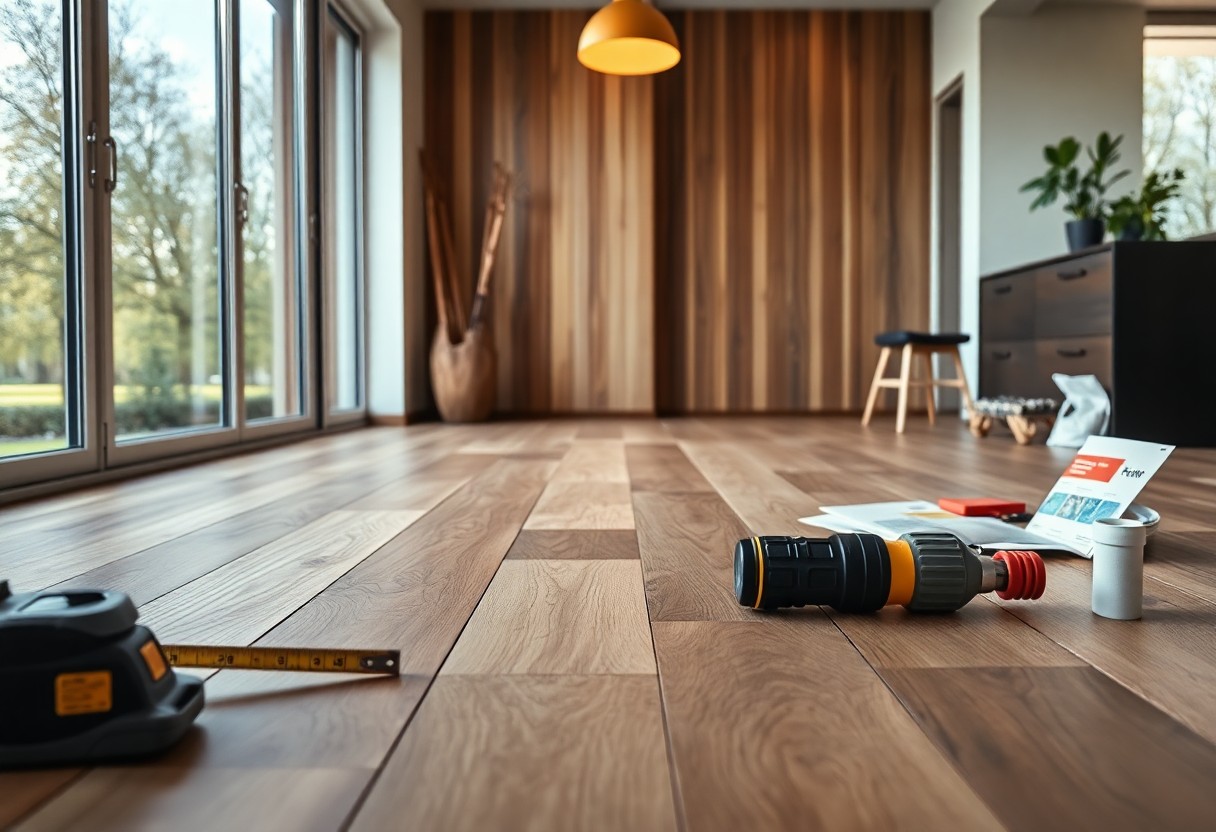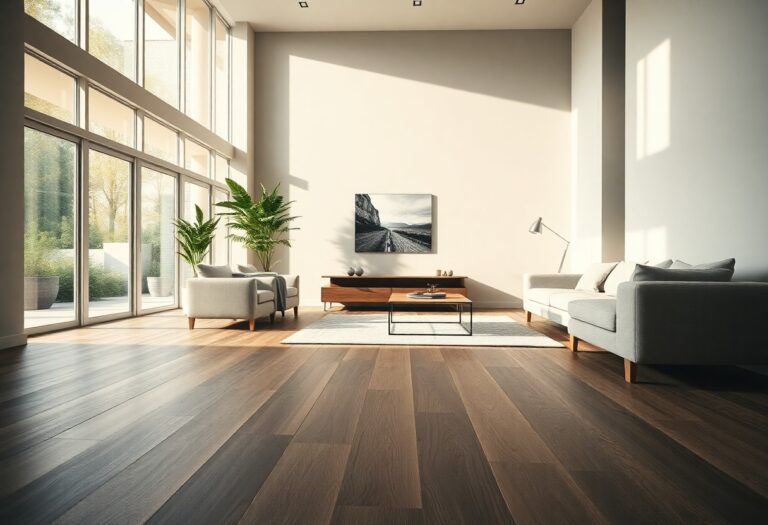It’s imperative to understand engineered flooring if you’re considering an upgrade for your home. This hybrid flooring option combines the beauty of hardwood with the durability of other materials, making it a practical choice for various settings. In this post, you will learn about the benefits of engineered flooring, its expected lifespan, and imperative care tips to maintain its appeal and performance in your space.

What is Engineered Flooring?
Engineered flooring consists of multiple layers of wood, offering the natural appearance of hardwood with added stability. The core layers are typically made from plywood or high-density fiberboard, while the top layer features real hardwood veneer, allowing for a diverse range of designs and finishes. This construction method makes engineered flooring more resistant to moisture and temperature changes compared to solid hardwood.
Composition and Design
The composition of engineered flooring includes a top layer of hardwood, a core of hardwood or synthetic materials, and a backing layer. This layered design not only provides structural integrity but also enhances performance in varying environments. A wide array of finishes and styles is available, allowing you to achieve the aesthetic you desire without compromising durability.
Types of Engineered Flooring
Engineered flooring comes in several types, each suited for different applications and preferences. Common options include hardwood veneer, laminate-infused surfaces, and wire-brushed textures. These styles vary in thickness, grain, and finish, offering diverse choices for special tastes and functional needs.
- Hardwood veneer: Authentic wood appearance
- Laminate-infused: Budget-friendly option
- Wire-brushed: Rustic, textured finish
- Mixed species: Diverse aesthetic appeal
- Wide plank: Contemporary styling
Thou, choose based on your room’s design!
| Type | Characteristics |
|---|---|
| Hardwood veneer | Real wood layer with high-end look |
| Laminate-infused | Cost-effective with easy maintenance |
| Wire-brushed | Distressed look for rustic interiors |
| Mixed species | Varied wood types for unique aesthetics |
| Wide plank | Modern appeal; less visible seams |
You can find a variety of engineered flooring types that accommodate specific climate conditions and design preferences. The thickness of the veneer layer can influence durability, while core materials enhance performance. Look for options offering finishes that align with your home’s style, from sleek modern to traditional rustic.
- Thick veneer for longevity
- Low-profile designs for smaller spaces
- Acoustic benefits for sound absorption
- Eco-friendly options for green homes
- DIY installation kits available
Thou can simplify your renovation with practical solutions!
| Feature | Benefit |
|---|---|
| Durability | Resistant to humidity and temperature changes |
| Variety of styles | Wide range of designs suitable for any décor |
| Cost-effectiveness | More affordable than solid wood flooring |
| Easy installation | Some types designed for DIY installation |
| Sustainability | Composed of sustainable materials and practices |
Benefits of Engineered Flooring
Engineered flooring offers numerous advantages, making it an ideal choice for many homeowners. This type of flooring is designed to withstand fluctuations in temperature and humidity, providing stability in various environments. Additionally, you’ll find a wide range of styles and finishes available, ensuring you can achieve the look you desire without sacrificing functionality. The combination of beauty and resilience makes engineered flooring a smart investment for both aesthetics and practicality.
Durability and Stability
Engineered flooring boasts superior durability due to its layered construction, which includes a hardwood veneer over high-density fiberboard or plywood. This design allows it to resist warping and cracking better than solid wood flooring, especially in areas prone to moisture, such as basements or kitchens. You can expect engineered flooring to last for decades with proper care, making it a reliable option for your home.
Aesthetic Versatility
Your options for design are nearly limitless with engineered flooring. Available in a variety of species, stains, and finishes, you can achieve a range of looks from rustic to modern. This flexibility means you can easily match your flooring to your existing decor or make a bold statement. Additionally, many manufacturers offer custom options, allowing you to create a unique look tailored to your taste.
Incorporating engineered flooring into your space enables you to blend traditional wood aesthetics with contemporary design trends. You might choose a rich, dark oak for a classic feel or a light, bleached maple to evoke a more airy ambiance. The ability to mimic various wood types means that you can evoke specific styles, such as Scandinavian minimalism or Mediterranean warmth, all while enjoying the practical benefits that engineered options provide. This adaptability makes it a favorite among designers and homeowners alike.
Lifespan of Engineered Flooring
The lifespan of engineered flooring typically ranges from 20 to 30 years, depending on various factors such as usage, maintenance, and quality of installation. This durability makes engineered hardwood a popular choice for both residential and commercial spaces where longevity is crucial.
Factors Affecting Lifespan
A variety of factors can significantly impact the lifespan of your engineered flooring:
- Quality of materials used
- Frequency of foot traffic
- Moisture levels in the environment
- Proper installation techniques
- Regular maintenance routines
This understanding of these elements can help you maximize the longevity of your flooring investment.
Comparison with Other Flooring Types
Engineered flooring stands out when compared to other flooring types, such as solid hardwood, laminate, and vinyl. Each material has distinct advantages and disadvantages:
- Solid hardwood offers classic appeal but is more susceptible to moisture and damage.
- Laminate is cost-effective but lacks the authentic wood look.
- Vinyl provides excellent water resistance but may not have the same aesthetic value.
- Engineered flooring strikes a balance between appearance and performance.
- Perceiving its durability and beauty can guide your choice effectively.
| Flooring Type | Lifespan |
|---|---|
| Engineered Flooring | 20-30 years |
| Solid Hardwood | 30-100 years |
| Laminate | 10-25 years |
| Vinyl | 10-20 years |
| Bamboo | 20-25 years |
Perceptions of durability and aesthetic appeal vary by flooring type. Engineered flooring provides the advantage of real wood’s looks while ensuring enhanced stability, making it ideal for varying environments and uses. Understanding these distinctions will assist in making an informed decision about your flooring choice.
| Flooring Type | Aesthetic Appeal |
|---|---|
| Engineered Flooring | High, offers real wood finishes |
| Solid Hardwood | Classic, timeless appeal |
| Laminate | Variable, mimics wood but often less authentic |
| Vinyl | Modern, versatile designs available |
| Bamboo | Unique, eco-friendly look |
Perceiving the aesthetic merits of each flooring type can effectively influence your final selection and design preferences. The balanced durability and elegant finishes of engineered flooring make it an appealing option for any home or property.
Care Tips for Engineered Flooring
To maintain the beauty and longevity of your engineered flooring, implement these care tips:
- Regularly sweep or vacuum to remove dirt and debris.
- Use a damp mop with a pH-neutral cleaner for deeper cleaning.
- Avoid excessive water exposure; never soak the floor.
- Place mats at entry points to reduce dirt and moisture.
- Use furniture pads to prevent scratches and dents.
Perceiving these simple practices can significantly enhance your flooring’s lifespan and appearance.
Cleaning and Maintenance
Regular cleaning is necessary for preserving the appearance of your engineered flooring. Sweep or vacuum daily to minimize dust and grit. For deeper cleaning, use a damp mop with a cleaner specifically formulated for wood floors, ensuring it’s pH-neutral to avoid damage. Annual professional cleaning can also help maintain its finish and prevent buildup of dirt and oils.
Avoiding Damage
Protecting your engineered flooring from damage is straightforward but requires diligence. Avoid dragging heavy furniture across the surface to prevent scratches. Use rugs in high-traffic areas and around furniture legs to reduce wear. Additionally, maintain consistent humidity levels in your home, as extreme fluctuations can cause the planks to expand or contract, leading to gaps or warping.
Common Myths about Engineered Flooring
Myth 1: Engineered Flooring is Not Durable
Many believe engineered flooring lacks durability compared to solid wood. In reality, the multilayer construction enhances stability and resistance to moisture, making it a strong contender for high-traffic areas. High-quality engineered flooring can withstand wear and tear, often lasting as long as solid hardwood with proper care.
Myth 2: It Can’t Be Refinished
Another common misconception is that engineered flooring cannot be refinished. While it has a thinner veneer than solid wood, many options allow for at least one or two refinishes. This offers you the ability to refresh your floors without the need for complete replacement.
Myth 3: It’s Only Suitable for Basements
Engineered flooring is often labeled as basement-only material. However, it is versatile enough for all areas of the home, including living rooms and bedrooms, thanks to its robust moisture resistance. You can enjoy the aesthetic of wood in any space without concern.
Installation Options and Considerations
Floating Installation
Floating installation allows you to place engineered flooring directly over an underlayment without adhering it to the subfloor. This method is ideal for DIY enthusiasts, offering flexibility and ease. With less labor-intensive requirements, you can install it over various surfaces, including concrete and tile, making it a versatile option for different settings.
Glue-Down Installation
For a more permanent solution, glue-down installation involves adhering the planks to the subfloor using wood adhesive. This process reduces noise and improves stability, making it suitable for high-traffic environments. Choose this method if you’re looking for enhanced sturdiness, particularly in commercial spaces.
Nail-Down Installation
If you prefer a traditional approach, nail-down installation secures planks directly to a wooden subfloor. This technique works best in areas of high humidity, as it allows the wood to expand and contract naturally. You’ll find this method prevalent in homes aiming for a classic finish, especially with thicker engineered boards.
Final Words
Summing up, engineered flooring offers a blend of aesthetic appeal and practical benefits, making it a smart choice for your home. With a significant lifespan and ease of maintenance, it withstands daily wear while retaining its beauty. By adhering to proper care tips, you can ensure your engineered floors remain in excellent condition, enhancing your living space for years to come.





